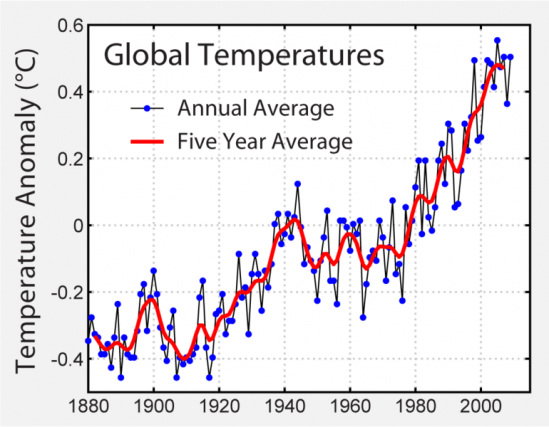Climate Change
Follow @ClimateRush
There’s been a lot of confusion about climate change. Some of it has been real scientific debate, but a lot of it has been generated by paid-up climate deniers funded by Exxon Mobile, who wanted to
rock people’s faith in science so that they’d buy more cigarettes. (Crazy but true – George Monbiot’s book Heat: How to Stop the Planet Burning tells the whole story.)
It’s true that science never gives absolute certainties. Instead, it gives probabilities, identifying events which have occurred so many times that it’s really unlikely that something different will
happen. These probabilities have allowed us to build skyscrapers, cure cancer, genetically modify plants and have test-tube babies. Of course, we shouldn’t accept science blindly. It has its limits.
But our whole world is also based on its principles and it’s our best hope of predicting and controlling the future.
The world’s climate is really complex and it takes huge amounts of computer power to model it. These models are full of problems and oversimplifications, but there are some things we know for sure (i.e. lots of people have done the same experiment and found the same results). One is that the level of carbon dioxide in the atmosphere, after being stable for a really long time, has been rising for the last two hundred years.

Carbon dioxide (CO2) concentrations (in parts per million) for the last 1100 years, measured from air trapped in ice cores (up to 1977) and directly in Hawaii (from 1958 onwards). 1769 is the year James Watts invented the steam engine (from Sustainable Energy: Without Hot Air by David Mackay)
Carbon dioxide is an important part of the greenhouse effect – the way that heat from sunlight is trapped on earth, making it warm enough for life. Because the system was stable for so long even the small rise in CO2 has made a big difference. Over the same time period global temperatures have been rising.

The instrumental record of global average temperatures as compiled by the NASA Goddard Institute for Space Studies. Reproduced from Wikimedia Commons.
It’s not that other things don’t make a difference. Sunspots affect the temperature on earth. Sulphur emissions banned twenty years ago are still high in the atmosphere, blocking sunlight and helping cool the earth. Things change year to year, and there are huge climate cycles. But the weather is visibly changing. The arctic sea ice may be gone in a couple of summers’ time – that’s ice that has been there for three million years. It’s possible that climate change is not man-made, that our emissions have nothing to do with rising temperatures. It’s possible, but not at all likely – and our whole civilisation is built on doing the thing that seems most likely. If a doctor tells us we only have a 10% chance of surviving cancer without chemotherapy almost everyone would get treated. Why don’t we trust climate scientists just because they’re only 95% sure climate change is man-made?
One last thing: beneath any article on the environment you’ll find someone, if not ten people, telling you that climate change is a huge conspiracy. They’re usually confused about who is behind
it – one day it’s communists, the next hippies or the UN – but they are totally certain that all the science is a hoax, that climate change isn’t happening, that if it is it wasn’t man-made, or if it was
man-made it’ll all be fine because we’ll get a nice tan.
We can’t tell you how much we wish they were right.
When the global leaders first met in the early 90s to discuss climate change they wanted to keep emissions at 1990 levels. Rather than rising by 1.1% a year, CO2 levels wouldn’t rise at all – a growth rate of 0%. Last year they grew by 3%. If this is a big conspiracy it’s a pretty unsuccessful one. We’d say that the power lies with those who are trying to say that emissions don’t matter, not the other way round.
Adapted from ‘Rush: the Making of a Climate Activist‘






